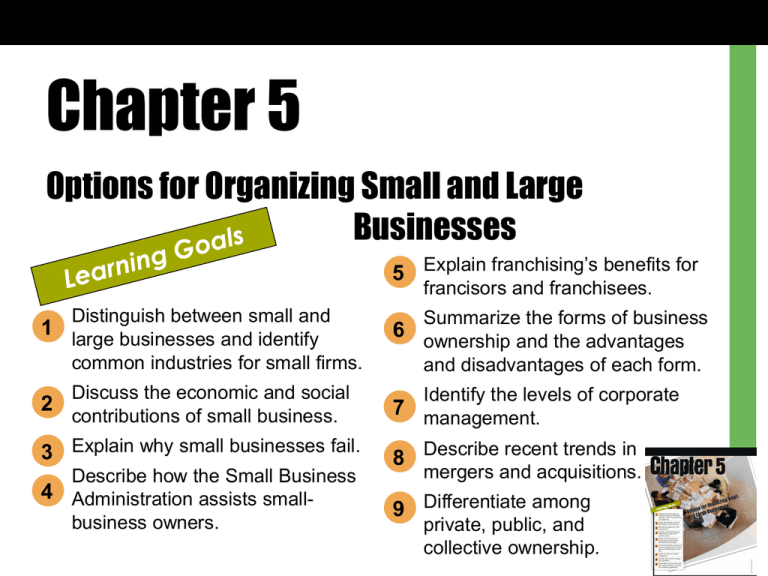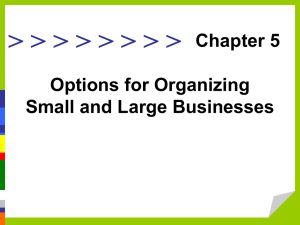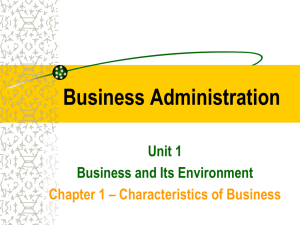Chapter 5 - Option for Organizing Small and Large Businesses
advertisement

Chapter 5 Options for Organizing Small and Large Businesses 5 Explain franchising’s benefits for francisors and franchisees. 1 2 Distinguish between small and large businesses and identify common industries for small firms. 6 Discuss the economic and social contributions of small business. 7 management. 3 Explain why small businesses fail. Describe how the Small Business 4 Administration assists smallbusiness owners. Summarize the forms of business ownership and the advantages and disadvantages of each form. Identify the levels of corporate 8 Describe recent trends in mergers and acquisitions. 9 Differentiate among private, public, and collective ownership. MOST BUSINESSES ARE SMALL BUSINESSES • Eighty-nine percent of firms with employees have fewer than 20. • Ninety-eight percent have fewer than 100 employees. • Almost half of all sales in the U.S. are made by small businesses. • Small business is a launching pad for entrepreneurs. Slice 1 Slice 2 Slice 3 Slice 4 What Is a Small Business? • Small Business Administration’s definition: An independently owned and operated firm that is not dominant in its field. Generally: • Manufacturing businesses that employ fewer than 500 workers. • Wholesalers that employ fewer than 100 workers. • Retailers and other service providers with annual sales no more than $6 million. • Agricultural business with annual sales no more than $750,000. • Small Business Administration has established standards for a variety of industries. Typical Small Business Ventures • Compete against the world’s largest corporations. Typical Small Business Ventures • Compete against the world’s largest corporations. • Just over half small businesses are home-based. • Since 1980, number of people working from home has doubled. • Rise of the personal computer, Internet, and other communication devices. • Benefits include lower costs, greater flexibility, freedom from cost of commuting. • Drawbacks include isolation and less visibility. • Internet can increase competitiveness of small businesses. • Three in five small businesses have an Internet presence. CONTRIBUTIONS OF SMALL BUSINESS TO THE ECONOMY Creating New Jobs • Three of every four new jobs are created by businesses with fewer than 500 employees. • Small businesses dominate fields with strongest employment growth. • More likely to employ younger and older workers than large firms. • More likely to hire workers who traditionally have difficulty finding a job. Creating New Industries • Many of today’s successful high tech firms—Microsoft, Dell, Cisco Systems, Yahoo!, and Google—began as small businesses. • Fuel local economies. • Adapt to fill needs of larger corporate community by acting as outsource firms. • Adapt to shifts in consumer interests and preferences. Innovation • Better than large firms at developing new and improved goods and services. • Example: Netflix, an alternative to Blockbuster which began as a small business and now has annual revenue approaching $1.2 billion. • Small firms develop twice as many innovations per employee as large firms. WHY SMALL BUSINESSES FAIL • One new business in every three closes permanently within two years. • Half fail after four years. • More than 60 percent are out of business within six years. • By the 10-year mark, 82 percent of all small businesses have closed permanently. Management Shortcomings • Founders’ strengths in areas such as marketing or interpersonal relations are often offset by shortcomings in areas such as finance or order fulfillment. • Words of warning for new small-business owners: • Learn the basics of business. • Recognize your own limitations. • Do market research to determine product viability and likely competitors. Management Shortcomings Inadequate Financing • Start-up expenses can eat resources before revenue begins coming in. • Uneven cash inflows and outflows can create difficulties. • Inadequate or high-interest financing. Government Regulation • Paperwork consumes billions of small-business dollars each year. • Congress eases some burdens through exemptions for small businesses. • Small businesses with fewer than 49 employees exempt from Family and Medical Leave Act. • U.S. Department of Labor provides online forms and guidelines for meeting many legal requirements. • Small firms have fewer resources to handle tax burdens of paying employee’s workers’ compensation insurance, Social Security payments, and unemployment benefits. INCREASING THE LIKELIHOOD OF SMALL BUSINESS SUCCESS Creating a Business Plan Business plan A written document that • Provides an orderly statement of a company’s goals. • The methods by which it intends to achieve these goals. • The standards by which it will measure achievements. • Common format: • An executive summary that briefly answers the who, what, why, when, where, and how questions for the business • An introduction that includes a general statement of the concept, purpose, and objectives of the proposed business • Separate financial and marketing sections that describe the firm’s target market and marketing plan as well as detailed financial forecasts of the need for funds and when the firm is expected to break even—the level of sales at which revenues equal costs • Résumés of principals—especially in plans written to obtain financing Small Business Administration Small Business Administration (SBA) The principle government agency concerned with helping small U.S. firms and advocate for small businesses within the U.S. government. Financial Assistance from the SBA • Provides guarantees for small-business loans by private lenders. • Provides some direct loans, but infrequently. • Guarantees microloans to start-ups and very small firms. • Licenses Small Business Investment Companies, which are run by experienced venture capitalists. • Underwrites Active Capital, which matches entrepreneurs looking for funding with potential investors. Other Specialized Assistance • Manages set-aside programs that reserve federal contracts for small businesses. • Provides information and advice about starting, financing, and managing a small business. • Manages the Small Business Training Network • Free online courses • Inexpensive training courses on topics such as taxes, networking, and start-ups in cities and small towns throughout the country • Free online library of more than 200 SBA publications and additional business resources Business Incubators Business incubator Organization that provides temporary low-cost, shared facilities to small start-up ventures. SMALL BUSINESS OPPORTUNITIES FOR WOMEN AND MINORITIES • The numbers of women-owned and minority-owned businesses are growing much faster than the overall growth in U.S. businesses. Women-Owned Businesses • More than 10.6 million women-owned firms in the U.S. employ almost 19.1 million people. • Forty-eight percent of U.S. businesses owned by women; one in five of these is owned by minority women. • Start companies for a variety of reasons. • Driven by an idea that they believe can help others. • Have a unique idea they want to bring to life. • Desire to strike out on their own when they lose jobs or feel frustrated corporate bureaucracy or hit the so-called glass ceiling. • Seek means to achieve flexible working hours to spend more time with their families. • Fastest growth occurring in construction, transportation and communications, and agricultural services. • Have rapidly established support networks. • Small Business Administration programs • Nonprofit support organizations Minority-Owned Businesses • Growth in number of businesses owned by African Americans, Hispanics, and Asian Americans has outpaced overall growth. Minority-Owned Businesses • Growth in number of businesses owned by African Americans, Hispanics, and Asian Americans has outpaced overall growth. • Immigrants own nearly 15 percent of all small businesses and are more likely to own small businesses than native-born citizens. • Minority business owners face considerable obstacles: • Tend to start businesses on smaller scale. • Have more trouble attracting investors. • Have harder time getting bank loans. THE FRANCHISING ALTERNATIVE Franchising Contractual agreement that specifies the methods by which a dealer can produce and market a supplier’s good or service. The Franchising Sector • U.S. franchises generate $1.53 million in sales and employ more than 18 million people. Franchising Agreements • Franchisee • Individual or firm purchasing the franchise. • Receives materials, equipment, and training from the franchisor. • Franchisor • Small-business owner who contracts to sell the good or service of the supplier. • Typically provides building plans, site selection help, managerial and accounting systems, and other services to assist the franchisee. Benefits and Problems of Franchising • Benefits • Prior performance record • Recognizable company name • Proven business model • Tested management program • Business training • Problems • Expensive franchise fees and future payments • Linked to reputation and management of the franchise INCREASING THE LIKELIHOOD OF SMALL BUSINESS SUCCESS Creating a Business Plan Business plan A written document that • Provides an orderly statement of a company’s goals. • The methods by which it intends to achieve these goals. • The standards by which it will measure achievements. ALTERNATIVES FOR ORGANIZING A SMALL BUSINESS • Every firm falls in one of three categories of ownership. Changing Legal Structures to Meet Changing Needs • A person considering launching a new business should consider these factors when deciding on the proper form of ownership: • Personal financial situations and the need for additional funds for the business’s start-up and continued operation. • Management skills and limitations. • Management styles and capabilities of working with partners and other members of top management. • Concerns about exposure to personal liability. • Form of ownership can be changed. ORGANIZING AND OPERATING A CORPORATION Types of Corporations • Fall into three categories • Domestic corporation in the state in which it is incorporated. • Foreign corporation in states in which it does business other than the one in which it is incorporated. • Alien corporation in countries in which it does business other than where it is incorporated • A single company can operate under all three of these designations. The Incorporation Process Where to Incorporate • Can incorporate in any state. • More than half of Forbes 500 companies are incorporated in Delaware. The Corporate Charter • Most states requires three incorporators. • Incorporators file articles of incorporation. • State grants a corporate charter, a legal document that formally establishes a corporation. Corporate Management Stockholder Person or organization who owns shares of stock in a corporation. Stock Ownership and Stockholder Rights • Annual meetings, elections of company officers. • Shares classified two ways • Owners of preferred stock have limited voting rights, receive dividends before common-stock holders, and have first claim on assets (after creditors) if corporation is dissolved. • Owners of common stock have limited voting rights but are last to receive income distribution. Board of Directors Board of Directors Governing body of a corporation. • Hires chief executive officer. Corporate Officers and Managers • CEO, chief operating officer, and chief financial officer make most major corporate decisions. • Managers handle ongoing functions of the organization. • 2002 Sarbanes-Oxley Act tightened requirements of corporate boards and require CEOs and CFOs to personally certify the accuracy of their firm’s financial statements. Employee-Owned Corporations • Workers buy shares of stock in the company that employs them. • Growing popularity: 11,400 firms employing nearly 10 million people. • Employees share in wealth the company generates. • Managers want employees to care deeply about company’s success. Not-for-Profit Corporations • Not-for-profit corporation Firm pursuing objectives other than returning a profit. • 1.5 million in the U.S. • Includes charitable groups, social-welfare and educational organizations, religious congregations, political parties, and labor unions. • Exempt from paying taxes. WHEN BUSINESSES JOIN FORCES Mergers and Acquisitions (M&A) Merger Combination of two or more firms to form one company. • Vertical Combines firms at different levels in the production and marketing process to ensure adequate flow of raw materials and supplies or increase distribution. • Horizontal Joins firms in the same industry that wish to diversify, cut costs, or offer expanded product lines. • Conglomerate Combines unrelated firms to diversify, spur sales growth, or spend a cash surplus. Acquisition Procedure in which one firm purchases the property and assumes the obligations of another. Joint Ventures: Specialized Partnerships • Joint venture Partnership formed between companies for a specific undertaking. • Example: Transport4, a joint venture among four U.S. pipeline companies to better service oil refineries that use their services. PUBLIC AND COLLECTIVE OWNERSHIP Public Ownership • A unit or agency of government owns and operates an organization. • Example: Pennsylvania Turnpike Authority. Government-Owned Corporations • Can result when private investors are unwilling to invest in a high-risk but socially important project. • Example: Rural electrification program of the 1930s. Customer-Owned Businesses: Cooperatives • Cooperative (co-op) Collective ownership of a production, storage, transportation, or marketing organization. • Example: Credit unions.








